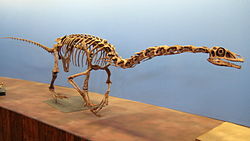Falcarius
|
Falcarius Temporal range: Early Cretaceous, 126 Ma |
|
|---|---|
 |
|
| Reconstructed skeleton, Natural History Museum of Utah | |
| Scientific classification | |
| Kingdom: | Animalia |
| Phylum: | Chordata |
| Class: | Reptilia |
| Clade: | Dinosauria |
| Order: | Saurischia |
| Suborder: | Theropoda |
| Clade: | †Therizinosauria |
| Genus: |
†Falcarius Kirkland et al., 2005 |
| Species: | †F. utahensis |
| Binomial name | |
|
Falcarius utahensis Kirkland et al., 2005 |
|
Falcarius is a genus of therizinosaurian dinosaur found in the Cretaceous of east-central Utah, United States. Its name is derived from the word "sickle", falcarius in Latin being a sickle cutter, which scientists have used to describe its large clawed hands.
Falcarius was a 4 metres (13 ft) long, bipedal herbivore. It had a small head and a long neck and tail.
The description of Falcarius (2005), following that of therizinosauroid Beipiaosaurus from the Early Cretaceous of China in 1999, clarifies the early evolution of the Therizinosauria and their relationship with the larger group of theropod dinosaurs, because Falcarius is a transitional form between older theropods and the much changed Therizinosauridae.
From examining fossilized bones from several individual animals, scientists have shown that Falcarius utahensis averaged 3.7 to 4 m (12 to 13 ft) in length and was just over 1.2 m (4 ft) tall. Gregory S. Paul in 2010 estimated the weight at a hundred kilogrammes. The smallest juvenile individuals found had a length of about half a metre.
Zanno in 2010 established some autapomorphies, unique derived traits of Falcarius. On the underside of the braincase there is a well-developed depression, the recessus basisphenoidalis. At the back of the head there are deep depressions below the occipital condyle and on the subotics, each with several pneumatic grooves. On the thumb claw the raised attachment point for the tendon of the extensor muscle is bordered by deep grooves for ligaments. The large skull opening in the snout, the fenestra antorbitalis, is positioned in a depression which reaches the side of the nasal bone. There are at least five pairs of conical teeth in the front of the lower jaws. These teeth are hollowed-out at the inside. On the underside of the vertebrae of the neck there is a depression with at the mid-line a ridge. The vertebrae of the back have below their front extensions, the prezygapophyses, a groove which is divided in three smaller depressions. The middle vertebrae of the back have a second ridge extending from the base of the upper rib joint, the diapophysis, to the back of the vertebra. In the arm, the shaft of the humerus is reinforced by powerful, somewhat obliquely placed, thickenings extending towards the condyles of the lower joint, which swellings have a hollow front edge. The front edge of the hip joint has a well-developed swelling, pointing sideways to the back, on the pubis.
...
Wikipedia
